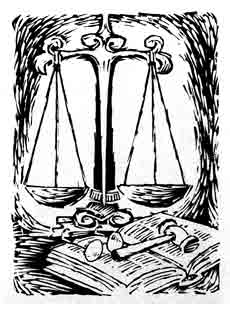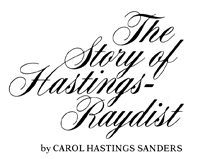T
he early months of 1954 brought substantial developments to both instruments and Raydist.
On the instrument side of the business, Charlie Hawk was busy setting up the manufacturer's representative sales program. Hawk had begun last November, taking off in his station wagon on two- to three-week forays, spending a couple of days in each of half a dozen cities. Once in a city, he'd get in touch with potential reps, tell them about HICO instruments, and discuss with them what they thought a fair arrangement would be.
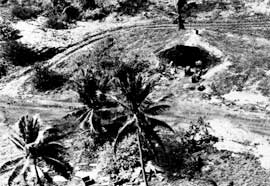
In preparation for initial shock wave of H-Bomb blast, Raydist reference station is set up in underground site.
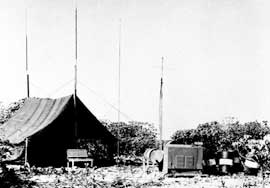
Raydist relay station.
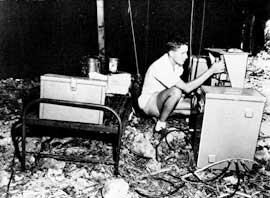
Carlton Howard of RNC readies Raydist relay equipment before zero hour.
|
By February, the details of the working arrangement between HICO and its reps had been worked out, and Hawk was signing up reps for various territories in the Northeast. The South and the Midwest soon followed. By July only several Western states were yet to be covered. After these would come Canada.
The line of instruments was expanding. Especially promising was the new vacuum indicating and control system, but there were also new panel-mounted vacuum gauges and improved Air-Meters.
At the same time, excitement on the Raydist side of the business ran high because Raydist had been chosen for use on the March 1954 hydrogen bomb tests in the Pacific. As part of the tests, the Air Force wanted to study the effects of the bomb blast on planes flying in the area. It was planned that two planes would be flying at known distances and altitudes from ground-zero at the time of detonation.
After a series of comparative tests with other equipment, Raydist was chosen to track these aircraft. Several months in advance of the tests, a transmitter was installed on each plane. Then a crew of four Raydist men was sent to the Pacific. On various atolls they set up Raydist antennas and relay stations that had been especially engineered to withstand the intense initial shock of the blast and the high wind velocities that would follow. During the blasts they manned Raydist master stations on a nearby ship.
Twenty-five years later, Raydist engineer Bob Cayouette still has vivid memories of that assignment: "On that job I would have enjoyed working for the company absolutely free for the whole four months. It was an awesome experience to see things like this happening first-hand."
I
mmediately after the bomb tests, HICO had its first booth in the IRE (Institute of Radio Engineers) show held in New York City. The show hosted 40,000 attendees, and HICO had put a lot of effort into developing an exhibit that would attract attention.
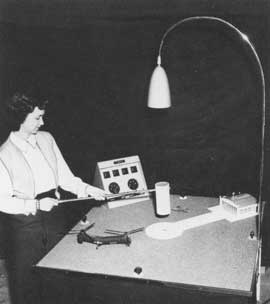
HICO employee Diane Hopla tries out Raydist exhibit destined for the IRE show.
|
Visitors nearing the booth first heard a 400 cycle tone and then saw someone waving a strange wand over a tabletop model of a heliport. Inside the cone of the wand was a speaker to simulate a Raydist transmitter. Stationed around the heliport were microphones taking the place of the usual Raydist radio receivers. The microphones were connected to Raydist phasemeters that tracked the position of the wand "helicopter" as visitors "flew" it around the heliport.
The results were more than gratifying. The aisle beside the HICO booth was packed throughout the show. Everyone wanted the chance to play with the wand and watch the phasemeters track his "flight."
M
eanwhile, behind the scenes, Hastings was besieged with problems.
The patent suit with Seismograph Service Corporation was a large drain on the finances of the company and the time of its officers. Countless hours were spent consulting with patent attorneys, gathering data and documents, answering interrogatories, and making trips to New Orleans for pre-trial depositions. This promised to continue through the summer and fall, when the trial would begin.
On another front, over the years the company had had many arguments with government cost inspectors, who came in to audit records in connection with the cost-plus-fixed-fee contracts.
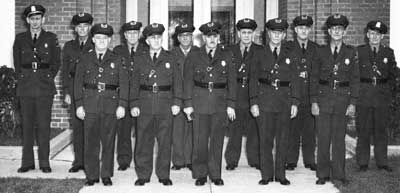
To meet the security regulations for classified contracts, HICO hired a dozen watchmen to guard its facilities. (1953)
|
One example of the disputes that plagued dealings between Hastings and the auditors was the issue of the guards. Because the company was working on classified military contracts, the government required that guards be posted around any building where classified work was being done. Since the Hastings facilities were spread out, a lot of guards were necessary.
When this first began, in 1948, the cost inspector had said it was normal for industrial plants to call a guard's salary general overhead, and then to prorate it between government and commercial business on the basis of direct labor dollars. In the first few months most of the business in the shops was commercial, and the result of prorating the security costs on a labor-dollar basis almost put the company into bankruptcy. Hastings discussed the problem with the Head of Cost Inspection of the Navy Department in Washington, and they agreed that all security costs should be charged directly to classified contracts.
In the years since, a stream of cost inspectors and auditors from the Army, Navy, and Air Force had come to the company to go over the various contracts, and each one of them had challenged this policy. Every time, Hastings had gone over the reasons for the policy. He had also told them that any time the government refused to accept the full expense of the guards, he would immediately dispense with them. Since there were many contracts, many levels of inspectors and auditors, and a high turnover in auditing personnel, by 1954 Hastings had gone through this routine more than fifty times. Now there was to be yet another audit, this time a "comprehensive" audit of all cost-plus contracts by the General Accounting Office.
The GAO personnel arrived in late April, and an audit began that lasted for four months.
Nor were these all the problems. During the Korean War, HICO and RNC had been receiving over 75 per cent of their revenues from military contracts. The end of the war had brought drastic reductions in military appropriations. The Bureau of Ships, for example, HICO's biggest customer, had had its appropriations slashed by eighty per cent compared to the wartime years, and now had virtually no funds available for Raydist.
The decline in military contracts and the financial drain of the patent suit called for immediate cutbacks. The work force was reduced, and by May the 39th Street plant had been vacated and put up for sale. The purchasing department and the stockroom were moved to the Warwick building, and the main office and accounting were transferred to Southampton.
I
n the summer of 1954, RNC was scheduled to make a two-month survey for the Army Corps of Engineers of a series of distances between Cuba, Haiti, and Jamaica. The line between Jamaica and the northwestern tip of Cuba, about 450 miles, would be the longest distance ever measured electronically.
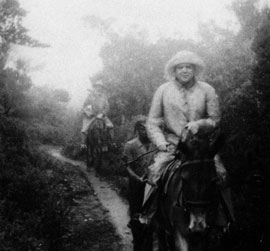
Charles Hastings rides mule up Blue Mountain in Jamaica.
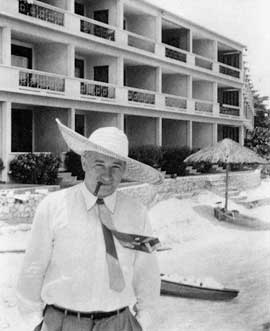
Arthur Samet takes it easy at a hotel in the Bahamas.
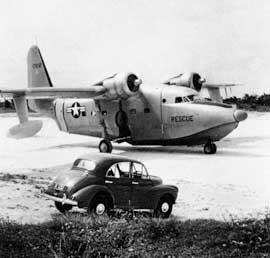
Plane used to fly survey missions during Haiti-Jamaica-Cuba survey.
|
Shortly before the survey was to begin, Charles Hastings, Arthur Samet, and Floyd Gibbs, project engineer for the survey, went to the area to choose sites for Raydist installations. Mountaintops would be good, but they needed to be accessible, and have large, fairly level, cleared areas for the equipment.
One potential site in Jamaica was the top of Blue Mountain, at an altitude of 7402 feet.
Floyd Gibbs remembers the trip:
Blue Mountain is the highest point of land in Jamaica, and is known for the fine coffee that grows there. It may have had fine coffee, but it had no roads up the mountain. Getting to the top required riding five hours on muleback and then climbing the last few hundred feet.
There weren't enough mules available, so Arthur and Charles flipped a coin to see which of the two would get to go up. Charles won. Arthur would check out a site on another mountain on a different day. His trip would be easier, but less spectacular.
The Blue Mountain party was made up of Walter Scales from the Corps of Engineers, Charles, our guide, and me. We started out at the crack of dawn. Walter, a man twenty years my senior, drew the only horse—an energetic animal who was prancing all over the place. Charles and I each drew a draggy old mule.
About halfway up the mountain the sun went away and it began to rain. The trail first got slick, then turned into a river of mud. We were all soaked from head to toe, and as miserable as we had ever been in our lives. Eventually we got to the top of the mountain, checked out the site, and took our lunches out of wet paper bags. The sandwiches were soaked through, but we didn't dare not eat them because we'd have starved before we got down the mountain.
No sooner had we started down the mountain when Walter's horse threw him and Walter broke his collarbone. So there we were, a five hour mule ride between us and civilization with an elderly man with a broken collarbone. Walter didn't want the horse any more then, so I traded him my mule for his horse and we slowly made our way back down the slippery trail.
When we got down, Arthur was waiting for us in a Jeep. He had spent a pleasant day at the hotel, enjoying the swimming pool and the bar before coming to pick us up. After he learned how our day had been, he gallantly assured Charlie that in the future he would be delighted to lose a coin toss with him anytime!
T
he results of the government audit were grim. On Navy contracts the auditors again disallowed the costs of the guards and a host of other items that had supposedly been settled many times before. They not only disallowed such costs incurred during 1954, but made the disallowances retroactive to 1950! Altogether the disallowed costs on Navy contracts came to $115,000.
But that wasn't all. The GAO wrote letters to the Air Force, urging it to challenge costs charged on the Sierra Wave project and the Bahama Islands survey. The disallowed charges here amounted to $28,500.
Since HICO was also having trouble collecting $45,000 from the Army under a terminated contract, the grand total came to $188,500 that the government was either disallowing, withholding, or trying to recapture. All this in a year when the company was spending $60,000 defending itself in a patent suit. The timing couldn't have been worse.
As November came, Hastings was thinking more and more seriously about discontinuing cost-plus-fixed-fee contracts altogether. The recordkeeping and dealing with the auditors had been a thorn in the company's side for years, but it had been thought necessary to put up with them and that the company was making a profit on the contracts. Now it appeared otherwise.
"It's a game of 'Heads, you break even; tails, you lose,' with the government continually flipping the coin," he concluded.
To check out his thinking, he contacted other companies doing a similar type of business. He could find no successful company of his size that did a large percentage of both commercial business and government cost-plus business. Time after time the top executives of these companies told him that a small company could do either all government business or all commercial business, but that it was impossible to mix large amounts of the two profitably.
A
t the next meeting of the Board of Directors, held at the end of November, he formally proposed a drastic change in the course of the company. His resolution read:
WHEREAS the Hastings Instrument Company has suffered serious losses on the total CPFF [cost-plus-fixed-fee] contracts during the past fiscal year, and
WHEREAS the overhead, accounting procedures, and regulations required for this type of contract have resulted in severe financial hardships to the Company, and
WHEREAS a certain minimum amount of CPFF business is absolutely necessary to operate under the overhead requirements of this type of contract and due to the simultaneous completion and near completion of several large research and development contracts of this type under which we have been operating for the past several years, we do not now have this required minimum of CPFF business,
BE IT THEREFORE RESOLVED that the Hastings Instrument Company discontinue entering into CPFF contracts with the Federal Government.
A lengthy discussion followed. They discussed the amount of cost-plus work they would be likely to get if they continued such work. They discussed the prospects for expanding their commercial business. They discussed how the elimination of cost-plus work could be put into effect. And they voted to adopt the proposal discontinuing cost-plus-fixed-fee contracts. In the future, Hastings Instrument Company would pursue a new course.
The second order of business was salaries. The patent suit and the disallowed costs had put the company into a difficult financial position. There were going to be hard times ahead. Budgets had to be trimmed, and the first step was to be a cut in officers' salaries. It was unanimously agreed that the salary of Charles Hastings be cut by half, and that the salaries of the other officers be cut by one third.
W
ith the company no longer accepting new government research and development contracts and with the phasing out of existing contracts as soon as possible, there were major layoffs.
Ray Doyle remembers:
Cuts were across the board—engineers, technicians, shop personnel, bookkeepers, everything. Jim Benson put out some feelers about selling our R&D organization as a whole, but the companies he contacted were more interested in recruiting personnel for their own organizations.
We did as much as we could to help our people find new work. Fortunately, it was a strong time in the economy, and jobs were plentiful. In fact, the demand for engineers was so strong that ironically we had to give raises to some of the ones we were keeping at the same time as the officers were having their pay cut. In November 1954 the work force had numbered approximately 150. By February 1955, less than 40 were left.
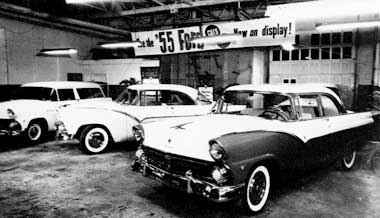
In the fall of 1954, the 39th Street building, still for sale, is leased for a "sneak preview" of 1955 Fords.
|
With less than forty employees, there was no need for two plants. Keeping Southampton was the obvious choice. Being adjacent to the water made it better for Raydist, and the larger, more accessible Warwick plant could command a higher price on the market. All operations were quickly consolidated at Southampton, and the Warwick building, like the 39th Street plant, sported a "For Sale" sign on its lawn.
It was not clear that the company could survive. Even the officers had doubts.
Charles and Mary Hastings were close friends with Ray Doyle and his wife, and as a general rule business was never discussed when they saw each other outside the office. But now things were different. The Doyle home was just down the street from the Hastings home, and many times during this period Charles and Mary walked down to the Doyle home after dinner to discuss the day-to-day situation at the company. "We're going to do everything we possibly can to pull this company through," Charles told Ray, "but I'm not sure we'll make it."
There were also doubts among the employees. A few who had been asked to stay left anyway, hoping to find jobs with companies in whose future they had more confidence. But those who remained were determined that the company would weather the storm. Often working nights and Saturdays, they pitched in to do whatever they could to get the company back on its feet.
The layoffs had been so severe that many in the community thought the company had already gone under. Lee Marks recalls trying to cash her payroll check at the grocery store early in 1955: "Hastings Instrument Company?" said the clerk, looking skeptically at the check. "I thought that company went out of business."
E
arly in 1955, Charles Hastings sat down to write the "Report from the President" for the 1954 Annual Report. It would be a hard report to write. He could cover the events, but there was no way he could convey the pain and frustration of that turbulent year.
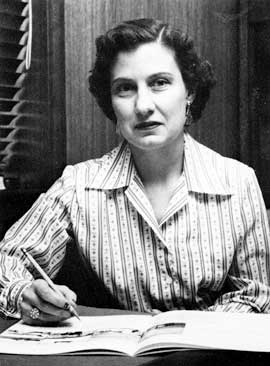
Every year Mary Hastings prepares the annual report to the stockholders. In addition she handles the company's manuals, technical reports, advertising, and public relations. (1956)
|
The events at the trial of the patent suit had convinced him that the officials of Seismograph Service Corporation had deliberately conspired to do him in by stealing his ideas. Now the government was trying to do him in by disallowing costs they had agreed for years to pay. The injustice of it rankled him. Recalling a common expression of the time, he began his rough draft with a succinct characterization of the situation as he saw it: "We wuz robbed!"
When he completed his draft, he handed it to Mary and asked her to go over it.
"Your opening sentence won't do," she told him. "You just can't say it that way in an annual report, even if it is true. What you say will have to be written in a formal style."
She began rewriting, and eventually the report opened with a somber tone.
Your company completed its tenth year of operations in 1954. While the success of Raydist and the increase of standard instrument sales were bright spots, the year was one in which we faced serious obstacles and some setbacks.
This company has consistently had to face a great many problems, but it is particularly unfortunate that several major problems were encountered simultaneously during the past year. Their number and magnitude have unquestionably been a severe drain on our efforts and our finances and have interrupted our continued progress and growth.
It went on to explain that the patent suit had been extremely time-consuming and expensive, but had finally gone to trial and they were expecting a favorable decision. Next it told the stockholders about the disallowances and the drop-off in government R&D contracts.
Fortunately there were some bright spots to mention about the company's '54 performance, such as sharply increased instrument sales, improved Raydist equipment, and the company's performance in the H-bomb tests.
But then the report was forced to return to unpleasant facts.
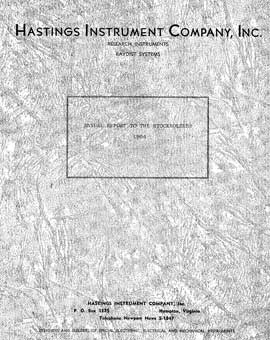
Instead of their typical professionally printed annual report, the stockholders of 1954 received only six typewritten, mimeographed pages bound in a plain cover.
|
Unfortunately, it was not possible to present a complete and audited financial statement at this time since our accountants cannot close the books and audit them until the items in dispute are either accepted or formally disallowed. Every effort is being made to complete this work as rapidly as is possible under the circumstances, and your copy of the financial statements of the company for 1954 will be mimeographed and mailed to you for inclusion in this report just as soon as possible.
There are, however, certain points I should like to mention here regarding our present financial position. Had it not been for the disallowances, both current and for past years, your company would have shown a substantial profit even after the excessive patent litigation costs. Had there been only current disallowances, I believe we would still have shown a reasonable profit. With the patent costs, the current disallowances for 1954, and the retroactive disallowances for previous years all occurring within the same year, we unquestionably will show a loss at this time. This loss will be in part reimbursed by refunds of taxes paid on profits in earlier years.
In view of the present financial position, the management has made every effort to consolidate its position by making a thorough examination of overhead expenses and excess facilities and drastically reducing or eliminating all but the most essential expenses. In some cases we have eliminated expenses which we believed were sound and necessary in the long run but which could not be afforded at this particular time. In addition to these measures, the officers have voted themselves a substantial reduction in salaries during this period of readjustment.
We wish to thank all of you who have been so considerate and understanding throughout these difficult times. Unquestionably, the early months of 1955 will continue to be ones of readjustment, but with the patent case and the cost disallowances settled and the shift in the company's main activities from Government-sponsored research and development work to increased manufacturing and sale of commercial equipment, we believe that the prospects for 1955 are good.
A
s it turned out, the financial statements for 1954 were not available until August 1955. By then many of the disputes over the disallowances had been settled, but a few were being appealed by HICO. The loss for 1954 was $40,250. Half of this amount would be recouped through tax refunds, but the result was still serious.
On the brighter side, by August Hastings could soften the blow to the stockholders by reporting that the company's profit for the first half of 1955 was over $40,000. Commercial sales were up, and the number of employees was again on the rise. Could the company survive without government R&D contracts? It certainly looked that way!
T
he prospects for the company became even brighter on September 29, 1955, when Judge J. Skelly Wright of the U.S. District Court in New Orleans, Louisiana, issued his verdict on the patent case. His opinion (135 F. Supp. 342) detailed the story of what had happened between Hastings and Seismograph:
The story of this case begins in 1947 after the oil industry became aware of the vast reserves of oil in the tidelands of the Gulf of Mexico. …
Phillips Petroleum Company, the principal client of the plaintiff Seismograph, had learned from Dr. Kenneth Norton of the United States Bureau of Standards that the young inventor Hastings had done considerable work in radio location involving the heterodyne phase comparison principle and that perhaps Hastings would have a solution to its problem of exact radio location of vessels working offshore. …
By April, 1947, when technically qualified representatives of Phillips called on him at his home at Hampton, Virginia, Hastings was able to demonstrate two versions of his Raydist system, the single user, or moving transmitter type, and the multi-user, or fixed transmitter type. … The Phillips representatives were elated with what they saw. They definitely felt that Hastings had a solution to their offshore survey problem. After obtaining approval from the management of their company, the Phillips representatives called on Dr. Hawkins, officer and director of Seismograph. They advised Hawkins of their visit to Hampton, Virginia, and explained in detail what they saw and heard there. …
Hawkins, an electronic engineer who had been making fruitless efforts using other systems such as Shoran, Radar, and Decca to obtain exact radio location of vessels working offshore, immediately grasped the significance of the Hastings disclosures as related by Phillips representatives. It was the first time that Hawkins or anyone connected with Seismograph had learned that the heterodyne phase comparison principle could be used to solve the problem of exact radio location, for which solution its principal client, Phillips, was pressing. Working feverishly, by May 11, 1947, Hawkins was able to produce a duplicate of the equipment, and the demonstration, which Hastings had shown the Phillips representatives some days earlier. Having been advised by the Phillips representatives of the modest circumstances under which Hastings' business was being conducted from his home, the further fact that obviously Hastings' patent position on his Raydist system was poor, Hawkins immediately forwarded to his patent counsel in Chicago disclosures for patent applications covering the Raydist systems and variations thereof.
Shortly before May 15, 1947, and at the request of Seismograph, a meeting with Hastings was arranged for the purpose of allowing Seismograph an opportunity further to investigate Hastings' Raydist systems to determine their applicability to Phillips' offshore exploration problem. On May 15, 1947, the Executive Vice-President of Seismograph, a geophysical engineer, went to Virginia and met with Hastings. At this meeting Hastings again described his Raydist systems, as previously disclosed to Phillips. Manhart proposed a business arrangement with the Hastings Instrument Company wherein Hastings would supply complete Raydist systems and would grant license rights to Seismograph. Upon Manhart's return to Seismograph's principal office at Tulsa, Oklahoma, he reported to the other officers of Seismograph all disclosures made to him by Hastings. In addition to disclosures of a technical nature, he reported that the Hastings company was financially weak, that Hastings was inexperienced in business matters, and that the Hastings patent position was probably poor. On May 23, 1947, after securing the approval of the Executive Committee of Seismograph, Manhart wrote to Hastings formally proposing the formation of a joint venture between Hastings and Seismograph and outlining the details of the joint arrangement, including the provisions that Hastings would supply the engineering design of the system for the company and that Seismograph would supply any applicable patent rights which it might obtain on the subject. Manhart in his letter asked Hastings to come to Tulsa empowered to act on the joint venture which he proposed.
Hastings visited Seismograph in Tulsa on June 16, 17, and 18, 1947. Hastings discussed with Hawkins and Westby, President of Seismograph, the joint venture proposed in Manhart's letter of May 23rd. Hastings also disclosed in detail a two-dimensional crossed hyperbola system using only three fixed transmitters and a switching principle on the transmitters wherein to conserve radio carrier frequencies. Hastings gave Hawkins and Seismograph the benefit of all his knowledge, experience and research on the Raydist systems and their practical operation, including the multiple modulation technique which is the subject of the Hawkins patent in suit. Hastings supplied this information to Seismograph with the understanding that the information imparted was for the benefit of and in furtherance of the joint venture which was under consideration. During these meetings in Tulsa on June 16, 17, and 18, Hastings was not advised by Hawkins or anyone connected with Seismograph that Hawkins was already prepared for filing a series of patent applications covering the Hastings Raydist systems and variations thereof. During these talks with Hawkins, Hastings disclosed that there was a significant patent which anticipated his Raydist system and that rights to that patent would have to be acquired. He did not, however, divulge to Hawkins the name or number of the patent, stating that he, Hastings, had already opened negotiations for such patent rights. The patent Hastings referred to was the Honoré patent, owned by the plaintiff, Mr. E. A. H. Honoré of Paris, France.
Hastings continued to cooperate with Seismograph throughout the months of June, July, August and September of 1947 in the joint business venture which Seismograph had proposed. Seismograph, on the other hand, unknown to Hastings, during this time was attempting to develop a Raydist system of its own suitable for use in offshore surveying, and by the end of July had made such progress in that endeavor that the management of Seismograph determined to advise Hastings that there would be no joint venture. Hawkins, who called Hastings by telephone for the purpose of so advising him, learned in the conversation that a competitor to Seismograph was making inquiries concerning the Raydist system. Hawkins thereupon determined not to advise Hastings of the decision to terminate the joint venture negotiations, and reported his conversation with Hastings to Seismograph's management.
Thereafter, in spite of the fact that a final decision had already been reached to terminate the joint venture negotiations, and in order to gain time to perfect its patent position and to complete the development of its own system based on Raydist, Seismograph, through its officers, particularly its president, Westby, and Hawkins, continued to delude Hastings with the promise of a joint venture. In fact, Westby actually told Hastings he had scheduled, and had Hastings prepare for, a demonstration of a two-dimensional Raydist system for Phillips representatives on September 8, 1947. This demonstration was cancelled by Westby by telegram to Hastings reading, "Due Unexpected Important Trip by Client's Representative, Unable Be There For Demonstration Monday. Will Inform You Later Suitable Date." The evidence shows that no Phillips representative was ever advised of the scheduled demonstration. Moreover, the Phillips representatives testified that there was no need for further demonstration, that they were satisfied by the first demonstration that Raydist was the answer to their problem. The telegram was the last communication from Westby to Hastings. Hastings did not hear from him, or other representatives of Seismograph, again, in spite of repeated efforts on his part to reach them by telephone.
During the months the joint venture negotiations were being conducted, Seismograph was active, unknown to Hastings, in building a patent position which would dominate his Raydist system. It acquired rights in various patents pertinent to Raydist which would block its development by anyone other than Seismograph. In particular, Seismograph was interested in obtaining rights in the Honoré patent to which Hastings had referred, without disclosing its name, as being basic to his Raydist system. Hawkins advised Mason, Seismograph's patent counsel in Chicago, of Hastings' reference to this patent and directed that every effort be made to identify it so that rights thereunder could be acquired. For reasons best known to himself, Hawkins also advised Mason of the name of Hastings' patent counsel in Washington. The manner in which the Honoré patent was identified as the one in which Hastings was interested forms a very sordid part of this case.
Mason engaged the services of a Washington associate, one Bailey, to make a search in the Patent Office in the hope of identifying the patent to which Hastings had referred. He gave his associate all the reports and other information necessary to acquaint him fully with the Raydist system together with his recommendations to Seismograph with reference to dominating this system. He informed his associate of the status of Seismograph's relations with Hastings, of Hastings' interest in the prior patent covering the heterodyne feature of Raydist, and of the fact that Hastings was negotiating to secure rights in that patent. He advised his associate of the identity of the Washington patent firm representing Hastings.
Mason's associate, Bailey, acting for Seismograph, contacted an employee of the Hastings Washington patent counsel who was then making a validity search at the Patent Office on a patent pertaining to radio navigation systems. Without disclosing to this employee his interest or intentions, Bailey was able, by deception, misrepresentation and concealment, actively directed by Mason, to learn from him that Honoré was the patent in which Hastings was attempting to acquire an interest. Mason congratulated Bailey on his excellent work, and on August 25, 1947, reported in full to Hawkins on the actions which had been taken at the Patent Office to determine Hastings' interest in the Honoré patent, and advised Hawkins that "The Honoré patent is definitely the patent in which they (Hastings) are interested."
Immediately upon receipt of this information, Seismograph moved quickly to obtain exclusive rights in the Honoré patent. On August 26, 1947, Mason dispatched an urgent and confidential letter to Paris to locate Honoré. The general counsel of Seismograph wrote its London representative, advising him that the matter of obtaining rights in the Honoré patent was extremely urgent because of the fear that someone in the geophysical field was currently endeavoring to purchase rights in that patent. Finally, early in October, Hawkins flew to Europe and negotiated and obtained for Seismograph exclusive rights in the geophysical field under the Honoré patent. It is these rights, so obtained, together with Seismograph's rights under the Hawkins patent, which Seismograph has brought this suit to enforce.
… The validity of the claims in suit of [the Honoré] patent … must be conceded.
With reference to the Hawkins patent in suit, a different result must be reached. In the first place, Hawkins was not the inventor thereof. … It was Hastings who conceived the idea of a double Honoré system using only three spaced transmitters. This idea was conveyed to the Phillips representatives and by them to Hawkins, who appropriated it as his own. …
The validity of the Hastings patent is unchallenged. The failure of Seismograph in this regard is obviously a tactical maneuver designed to avoid an invidious comparison with the position it has taken with reference to the validity of the Hawkins patent. Assuming, therefore, that the Hastings patent is valid, it is not infringed by Seismograph's Lorac system. …
The importance of the equitable issues in this case transcends the interest of the parties. "… The far-reaching social and economic consequences of a patent … give the public a paramount interest in seeing that patent monopolies spring from backgrounds free from fraud or other inequitable conduct …" … The robber baron morality of another day is no longer acceptable. Courts are insisting on increasingly higher standards of commercial integrity. … It has been long recognized that any patent obtained through fraud and dishonest dealings is unenforceable in a court of equity. … Now business information or trade secrets, not rising to the stature of invention, are protected. …
Even where it cannot be said that the parties stand in confidential relation, improper acquisition of another's business information or trade secrets subjects the perpetrator to liability in damages. … And a court of equity will enjoin the use of the business information or trade secrets so obtained. … No single test can be applied in all cases where improper acquisition of business information is charged. The inventiveness of the devious mind staggers the imagination. It is simply the difference between right and wrong, honesty and dishonesty, which is the touchstone in an issue of this kind.
In April, 1947, Hastings owned business information and trade secrets which Seismograph badly needed. Seismograph's principal client, Phillips Petroleum Company, was pressing Seismograph for solution of the radio location problem involved in offshore surveying. Experiments by Seismograph with other radio location systems had failed, and Phillips' technical representatives, after studying the Hastings system, advised Seismograph that Hastings had, what appeared to them to be, the answer to their problem. They advised Seismograph further that Hastings should be consulted. Instead of going to Hastings as upright business men, Seismograph determined to steal his work. Hawkins, an officer and director of Seismograph, on learning from the Phillips representatives the details of the Raydist system, immediately applied for patents on the system and variations thereon in the hope that inexperienced and impecunious Hastings had not already done so. But Seismograph did not stop there. It sent its executive vice-president to Virginia to learn more of Hastings' secrets and to offer him a brave plan by which they would form a joint venture to exploit the system. The brave plan was even reduced to writing and presented to Hastings for his consideration. Seismograph invited Hastings to its home office, further to pick his brains and milk him of the information on Raydist he had been so long acquiring.
During the time Seismograph was deluding Hastings with the offer of a joint venture, its own technicians, led by Hawkins, were perfecting their own version of the Raydist system based on the information Hastings had given them. By August 1, 1947, Seismograph felt it had no longer any use for Hastings, having obtained all the information it needed. Still it held the lure of joint venture before his eyes, so that he would not give his information to Seismograph's competitor, Offshore Navigation, and so that it, Seismograph, would have time to perfect its patent position, with particular reference to the Honoré patent. Seismograph's president, Westby, even conjured up a fake demonstration, and had Hastings prepare equipment for the demonstration, for Phillips representatives who were never even advised that a demonstration was to take place. Indeed, Seismograph even stooped to espionage on Hastings' patent counsel.
Thus it was that Seismograph was able to perfect its Raydist system which it called Lorac. Thus it was that Seismograph was able to obtain exclusive rights in the Honoré patent on which unwittingly Hastings had based his system. And now Seismograph has the effrontery to come into a court of equity to ask that its patents, so obtained, be used to enjoin the work of the very man who gave them life.
T
he court dismissed Seismograph's complaint, declared the Hawkins patent invalid, and required Seismograph to award HICO a sublicense in the geophysical field, covering the vendees of its equipment, on the Honoré patent, retroactive from the time the rights were acquired by Seismograph. Hastings was to pay Honoré royalties on the same basis as Seismograph.
Charles Hastings was elated. He had won a major victory. Although it would have been nice if the court had awarded him damages and attorney fees, he nevertheless had won the issues that counted. Raydist would not be silenced by the likes of Seismograph.
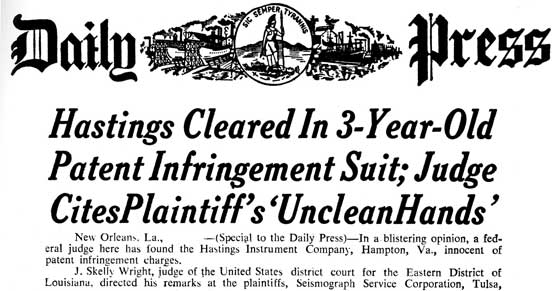
|
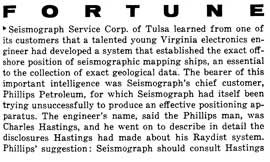
|

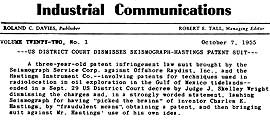
|
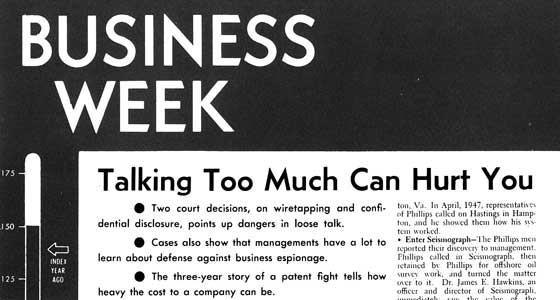
| |
The decision in the patent suit gets widespread publicity.
|
The decision generated considerable publicity. Business Week magazine ran a two-page story on the case. Fortune included the case among a group of others in a major story on business espionage. News of the decision also appeared in a variety of industry magazines and newsletters. A short mention of the story even cropped up in Pageant magazine, in an article entitled "I Was A Spy for Industry."
B
y the end of the year the company was in a sound financial condition. Sales were less than they had been a few years earlier—$730,000 compared with over $1,000,000 before—but sales dollars were being converted into profits at a higher rate than before. The year's after-tax profits, $63,000, were the highest in the company's history. To celebrate the turnaround, all employees received a cash bonus and stockholders received the largest cash dividend ever.
Both Raydist and instruments had had a good year.
A lot of Raydist equipment had been sold to Raydist Navigation Corporation, whose major job of the year had been nuclear bomb tests in Nevada during the spring and summer. Raydist was used more extensively in the Nevada tests than it had been in the Pacific tests, and again it turned in an excellent performance.
More equipment was sold to Offshore Raydist, which was doing close to $1,000,000 annual business supplying position data to petroleum crews in the Gulf of Mexico. And South America was becoming a good Raydist customer. The largest customer was Brazil, which bought Raydist to chart the mouth of the Amazon River. Systems were also sold to Venezuela and Argentina for hydrographic surveying.
Sales of Hastings instruments were strong, and the sales rep program was working well. The most important technical developments were an improved vacuum gauge and the new Hastings Jet-Vane, designed to measure higher wind velocities. The low-velocity Air-Meters were finding use in air pollution studies in Los Angeles.
The last government cost-plus contract had been completed in October, the 39th Street plant had been sold at a profit, and the Warwick plant had been leased out. A new wing had been added to the Southampton plant. It would be leased to RNC, which was still operating out of the small building adjacent to the former plant on 39th Street.
O
ne of the company's goals for 1955 had been for instrument sales to exceed $100,000. As December 31 came around, it looked close.
Charles Hastings called Lee Marks, who was tallying the figures. "Lee," he said, "What are your sales so far for the year?"
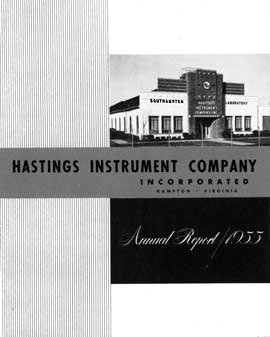
By the end of 1955 the company is on its feet enough to afford a professionally printed, well-illustrated report.
|
"I have ninety-nine thousand, seven hundred, and a few odd dollars," she told him.
"Oh," he said, disappointed. "I was so hoping this year we would go over $100,000."
"But wait," Lee said, "I haven't figured out the bills for the December repair orders yet. I always leave the repairs until last."
"Good," he said, encouraged. "Figure them out and let me know what your total figure comes to. Since today is the last day of the year, I'll be saying a few words to everyone before they leave for the day. I'd like to know the figures for instrument sales before then."
Lee went back to work. About three hours later she came up with her final figure for the year—$100,003.75.
Charles was delighted, but he couldn't help kidding her about it. "I'll tell you one thing," he joked, "If I were a customer I'd never get anything repaired when YOU needed money!"
That evening while the Hastingses were dressing for a New Year's Eve party, Charles chuckled as he remembered something Mary had said exactly one year ago. On that night, December 31, 1954, Mary had proposed a heartfelt toast to the New Year: We'll have no more of '54!
Indeed they had not. The troubles of 1954 were now well behind them.
next chapter >>
Copyright © by Carol Hastings Sanders
|
